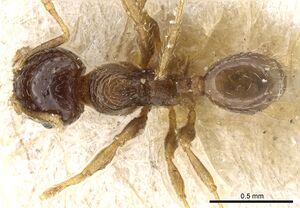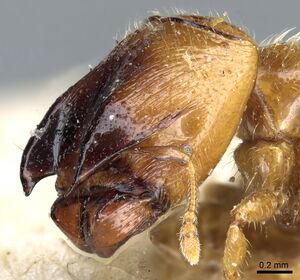Pheidole taurus
| Pheidole taurus | |
|---|---|

| |
| Scientific classification | |
| Kingdom: | Animalia |
| Phylum: | Arthropoda |
| Class: | Insecta |
| Order: | Hymenoptera |
| Family: | Formicidae |
| Subfamily: | Myrmicinae |
| Tribe: | Attini |
| Genus: | Pheidole |
| Species: | P. taurus |
| Binomial name | |
| Pheidole taurus Emery, 1906 | |
Nothing is known about the biology of taurus.
Identification
See the description in the nomenclature section.
Keys including this Species
Distribution
Buenos Aires and Santa Fé, Argentina (Kempf 1972b).
Latitudinal Distribution Pattern
Latitudinal Range: -26.808285° to -31.632389°.
| North Temperate |
North Subtropical |
Tropical | South Subtropical |
South Temperate |
- Source: AntMaps
Distribution based on Regional Taxon Lists
Neotropical Region: Argentina (type locality).
Distribution based on AntMaps
Distribution based on AntWeb specimens
Check data from AntWeb
Countries Occupied
| Number of countries occupied by this species based on AntWiki Regional Taxon Lists. In general, fewer countries occupied indicates a narrower range, while more countries indicates a more widespread species. |

|
Estimated Abundance
| Relative abundance based on number of AntMaps records per species (this species within the purple bar). Fewer records (to the left) indicates a less abundant/encountered species while more records (to the right) indicates more abundant/encountered species. |

|
Biology
The type series, and only known specimens, of Solenopsis abjectior were collected in association with a nest of P. taurus.
Castes
Worker
Minor
Images from AntWeb
   
| |
| Paralectotype of Pheidole taurus. Worker. Specimen code casent0904314. Photographer Z. Lieberman, uploaded by California Academy of Sciences. | Owned by MSNG, Genoa, Italy. |
Major
Images from AntWeb

| |
| Lectotype of Pheidole taurus. Worker (major/soldier). Specimen code casent0904313. Photographer Z. Lieberman, uploaded by California Academy of Sciences. | Owned by MSNG, Genoa, Italy. |
Nomenclature
The following information is derived from Barry Bolton's Online Catalogue of the Ants of the World.
- taurus. Pheidole taurus Emery, 1906c: 142, fig. 20 (s.w.q.) ARGENTINA. Combination in P. (Elasmopheidole): Forel, 1913k: 43. See also: Wilson, 2003: 141.
Unless otherwise noted the text for the remainder of this section is reported from the publication that includes the original description.
Description
From Wilson (2003): The most distinctive member of the aberrans group and one of the most unusual Pheidole species.
Major: frontal lobes drawn out into sharp, downward- and inward-curving horn-like extensions that reach beyond the clypeus to overhang the bases of the mandibles; laterally the edges of the frontal lobes extend past the margins of the head; bicolorous (see color below); carinulae of head confined to a broad band from the level of the frontal triangle to the transverse carina that delimits the beginning of the occiput.
Minor: promesonotal dorsum covered by semicircular carinae; carinulae on head mostly limited to antennal fossae and clypeus.
MEASUREMENTS (mm) Lectotype major: HW 1.08, HL 1.24, SL 0.42, EL 0.10, PW 0.66. Paralectotype minor: HW 0.48, HL 0.56, SL 0.42, EL 0.08, PW 0.34.
COLOR Major: concolorous reddish yellow, including midclypeus, but “horns” (extended frontal lobes), together with the frontal triangle and vertex, are dark brown, forming a “mask” over anterior dorsal surface of the head.
Figure. Upper: lectotype, major. Lower: paralectotype, minor. Scale bars = 1 mm.
Type Material
Museo Civico di Storia Naturale, Genoa ARGENTINA: Santa Catalina, Buenos Aires. (Wilson 2003)
Etymology
Gr taurus, bull, alluding to the horn-like frontal lobes of the major. (Wilson 2003)
References
- Emery, C. 1906c [1905]. Studi sulle formiche della fauna neotropica. XXVI. Bull. Soc. Entomol. Ital. 37: 107-194 (page 142, fig. 20 soldier, worker, queen described)
- Forel, A. 1913l. Wissenschaftliche Ergebnisse einer Forschungsreise nach Ostindien ausgeführt im Auftrage der Kgl. Preuss. Akademie der Wissenschaften zu Berlin von H. v. Buttel-Reepen. II. Ameisen aus Sumatra, Java, Malacca und Ceylon. Gesammelt von Her (page 43, Combination in P. (Elasmopheidole))
- Kempf, W. W. 1972b. Catálogo abreviado das formigas da região Neotropical. Stud. Entomol. 15: 3–344
- Wilson, E. O. 2003. Pheidole in the New World: A dominant, hyperdiverse ant genus. Harvard University Press, Cambridge, MA. (page 141, fig. major, minor described; see also)
References based on Global Ant Biodiversity Informatics
- Cuezzo, F. 1998. Formicidae. Chapter 42 in Morrone J.J., and S. Coscaron (dirs) Biodiversidad de artropodos argentinos: una perspectiva biotaxonomica Ediciones Sur, La Plata. Pages 452-462.
- Gallardo A. 1932. El subgénero Elasmopheidole en la República Argentina (Himenopteros Formicidos). Revista Chilena de Historia Natural 36: 178-182.
- Kempf, W.W. 1972. Catalago abreviado das formigas da regiao Neotropical (Hym. Formicidae) Studia Entomologica 15(1-4).
- Kusnezov N. 1978. Hormigas argentinas: clave para su identificación. Miscelánea. Instituto Miguel Lillo 61:1-147 + 28 pl.
- Pignalberi C. T. 1961. Contribución al conocimiento de los formícidos de la provincia de Santa Fé. Pp. 165-173 in: Comisión Investigación Científica; Consejo Nacional de Investigaciones Científicas y Técnicas (Argentina) 1961. Actas y trabajos del primer Congreso Sudamericano de Zoología (La Plata, 12-24 octubre 1959). Tomo III. Buenos Aires: Librart, 276 pp.
- Santschi F. 1925. Fourmis des provinces argentines de Santa Fe, Catamarca, Santa Cruz, Córdoba et Los Andes. Comunicaciones del Museo Nacional de Historia Natural "Bernardino Rivadavia" 2: 149-168.
- Vittar, F., and F. Cuezzo. "Hormigas (Hymenoptera: Formicidae) de la provincia de Santa Fe, Argentina." Revista de la Sociedad Entomológica Argentina (versión On-line ISSN 1851-7471) 67, no. 1-2 (2008).



